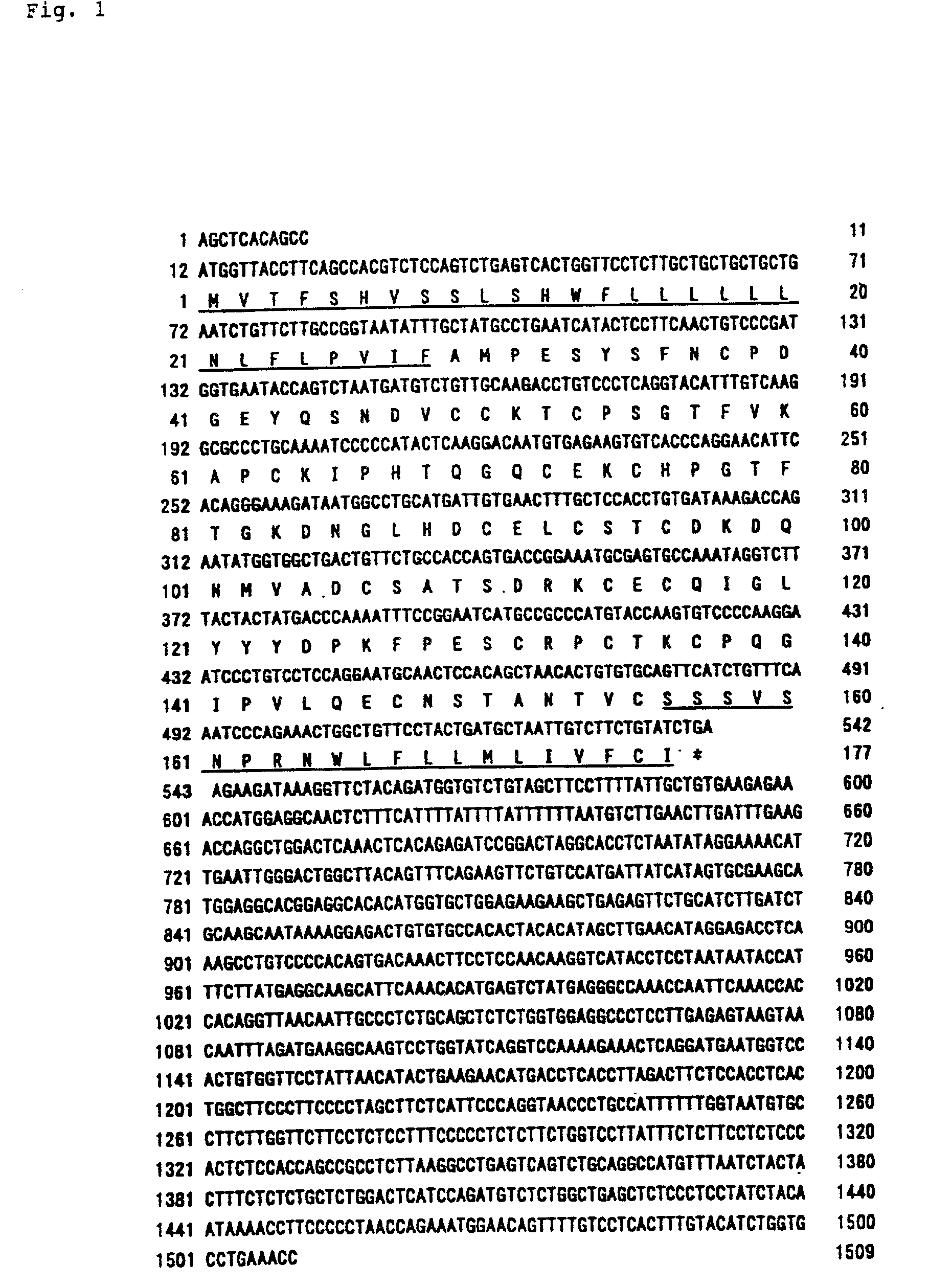Novel secretory membrane protein
a secretory membrane and protein technology, applied in the field of new secretory membrane proteins, can solve the problems of doubting that bmp can be used as a medicine to promote bone formation, and the effectiveness of enhancing bone formation has not yet been developed, so as to achieve enhanced alkaline phosphatase activity, inhibit cell proliferation, and alter the morphology of cells
- Summary
- Abstract
- Description
- Claims
- Application Information
AI Technical Summary
Benefits of technology
Problems solved by technology
Method used
Image
Examples
example 1
Cloning of 7F4 Genes
[0072] A gene encoding the secretory membrane protein which is expressed in mouse osteoblasts KUSA was cloned basically following the signal sequence trap (SST) method. First, pSR.alpha.Tac, to be used as a vector for expressing a library, was constructed as follows. Plasmid pKCR.Tac-2A (purchased from RIKEN gene bank), in which a full-length human IL-2 receptor gene is inserted, was digested with EcoRI and Eco47III to obtain the gene fragments coding the full-length Tac. The SacI site was deleted from the expression vector for animal cells, pcD-SR.alpha.-EF (Takebe, Y., Seiki, M., Fujisawa, J., Hoy, P., Yokota, K., Arai, K., Yoshida, M., Arai, N., Mol. Cell Biol. 8:466-472 (1988), SR alpha promoter: an efficient and versatile mammalian cDNA expression system composed of the simian virus 40 early promoter and the R-U5 segment of human T-cell leukemia virus type 1 long terminal repeat), and the resulting plasmid was digested with EcoRI. The above gene fragment enc...
example 2
Cloning of Whole cDNA and Sequencing
[0073] To isolate longer fragments, the 7F4 gene was cloned again by plaque hybridization from a cDNA library of KUSA cells using the above-obtained fragment as a probe. First, the KUSA cDNA library of oligo dT priming was prepared from mRNA extracted from KUSA cells, following the ZAP-cDNA Synthesis Kit protocol (Stratagene). Phages to be used for these 50,000 KUSA cDNA library clones were spread on plates and subjected to plaque hybridization using a part of the cDNA fragment obtained by the SST method and labeled with .alpha.32P dCTP as a probe. The filter fixed with the library was incubated in hybridization buffer (50% foramide, 5.times. SSPE, 5.times. Denhardt solution, 0.1% SDS, and 0.1 mg / ml herring sperm DNA) at 42.degree. C. for about 6 hours. The buffer was then replaced with a similar buffer but containing the probe, and the filter was further incubated at 42.degree. C. overnight. The filter was washed in 2.times. SSC-0.1% SDS several ...
example 3
Northern Blotting
[0074] Mouse multiple northern (MTN) blot (CLONTECH) and human MTN blot (CLONTHEH) were used as a filter for mice and humans, respectively. The regions comprising ORF of 7F4 cDNA (nucleotide number 120-480) were labeled with .alpha..sup.32P by multiprime labeling to be used as a probe for the hybridization. The filter for mice was incubated in ExpressHyb Hybridization Sol'n (CLONTECH) at 68.degree. C. for approximately 2 hours, then washed in 2.times. SSC-0.1% SDS for several times and in 0.1.times. SSC-0.1% SDS twice at 60.degree. C. The filter for humans was incubated in ExpressHyb Hybridization Sol'n (CLONTECH) at 68.degree. C. for approximately 4 hours, and washed twice in 2.times. SSC-0.05% SDS at 42.degree. C. for 10 min. The label was then detected using BAS2000 (Fuji Film). Localized expression of 7F4 was observed in all-tissues in mice (FIG. 3). In humans, 7F4 was also locally expressed, and typically, at a high level specifically in skeletal muscles and th...
PUM
| Property | Measurement | Unit |
|---|---|---|
| Fraction | aaaaa | aaaaa |
| Fraction | aaaaa | aaaaa |
| Fraction | aaaaa | aaaaa |
Abstract
Description
Claims
Application Information
 Login to View More
Login to View More - R&D
- Intellectual Property
- Life Sciences
- Materials
- Tech Scout
- Unparalleled Data Quality
- Higher Quality Content
- 60% Fewer Hallucinations
Browse by: Latest US Patents, China's latest patents, Technical Efficacy Thesaurus, Application Domain, Technology Topic, Popular Technical Reports.
© 2025 PatSnap. All rights reserved.Legal|Privacy policy|Modern Slavery Act Transparency Statement|Sitemap|About US| Contact US: help@patsnap.com



